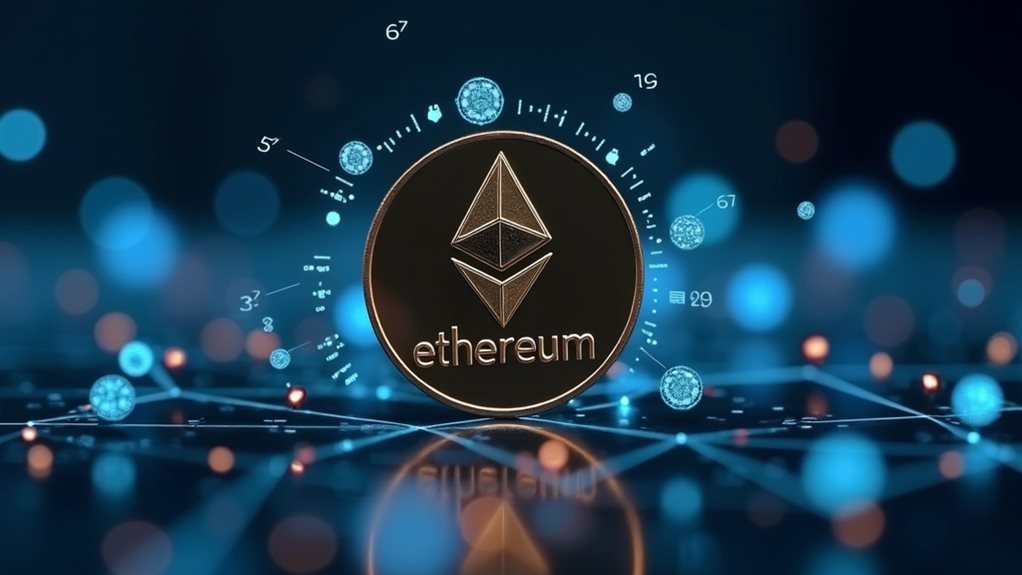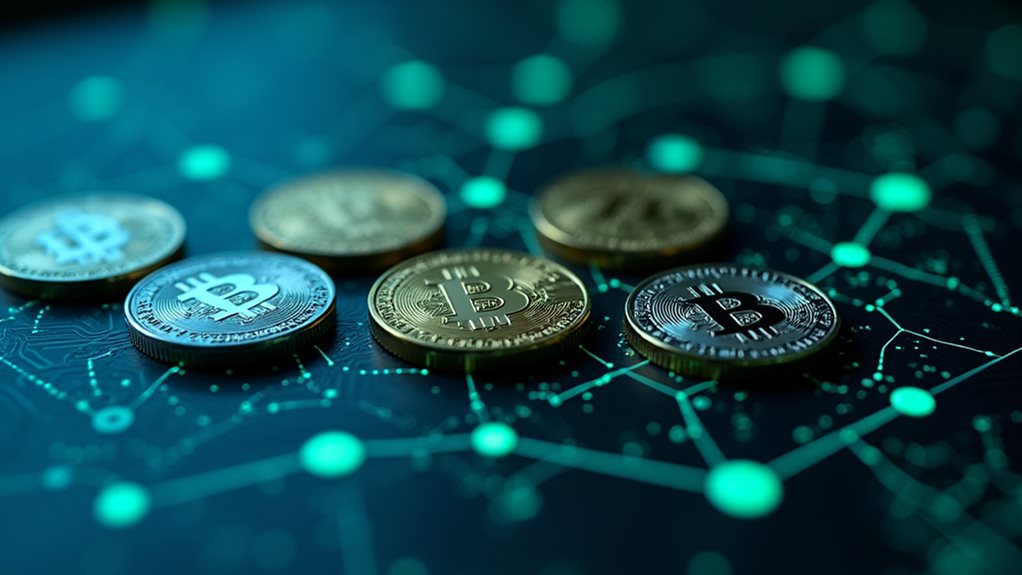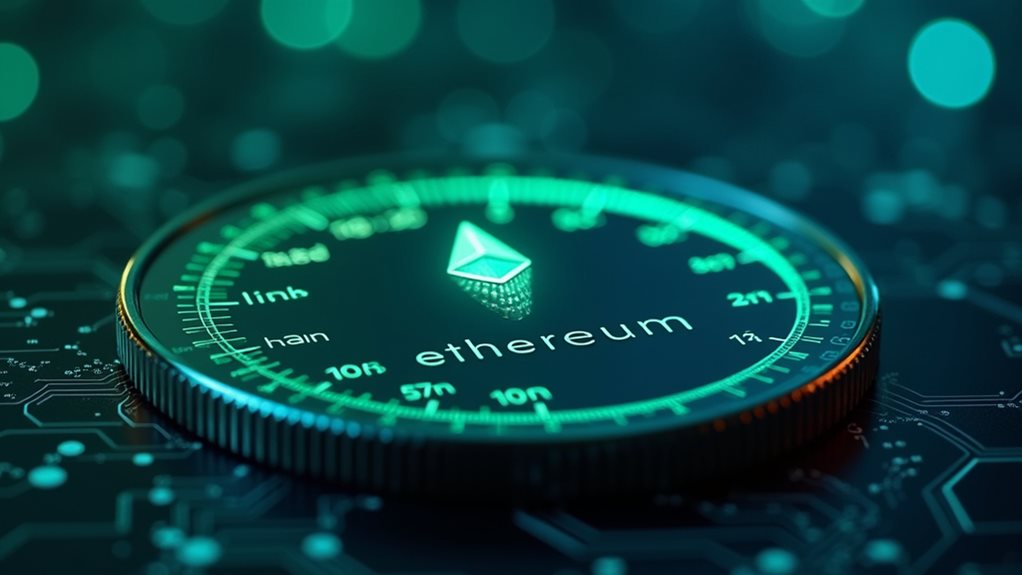Gas fees are transaction tolls you pay when using Ethereum and other blockchains. They’re calculated as (Base Fee + Priority Fee) × Gas Units Used, and can eat up to 30% of your profits. Yikes. Small trades get hit hardest when network’s busy. Different blockchains charge vastly different fees—Ethereum averages $3.78 per transaction while Solana costs mere pennies. Layer 2 solutions and smart timing can slash your costs by up to 100x. The crypto game changes when you understand the fee structure.
What Are Gas Fees and Why Do They Matter?

Transaction tolls. That’s what gas fees really are. You pay them in ETH or gwei whenever you do anything on Ethereum. Not optional.
These fees aren’t just random costs—they’re the backbone of blockchain economics. Validators (those folks securing the network) don’t work for free, you know. The fee structure rewards them for keeping things running and honest. Pretty important job.
Gas fees prevent spam. Try flooding the network with junk transactions and watch your wallet drain. Not so fun anymore, is it? The cost is calculated using gas limit × price, which determines exactly how much you’ll pay for each operation.
When network traffic spikes, so do fees. Simple supply and demand. Your transaction importance determines how much you’re willing to pay to jump the queue. Pay more, move faster. That’s crypto for you. Using Layer 2 solutions like Arbitrum or Optimism can significantly reduce these costs during high congestion periods.
The Mechanics of Gas Fee Calculation on Ethereum

While everyone obsesses over their trading strategies, they’re usually clueless about how gas fees actually work behind the scenes.
Ethereum’s gas fees aren’t just random numbers trying to ruin your day. They’re calculated using a formula: (Base Fee + Priority Fee) × Gas Units Used.
The base fee isn’t negotiable—it’s burned forever, literally removing ETH from circulation. That’s right, your pain is Ethereum’s deflationary gain.
* Base fee dynamics adjust automatically based on network congestion, rising or falling by up to 12.5% between blocks.
A simple ETH transfer requires 21,000 gas unit consumption (the bare minimum).
Your optional “tip” (Priority Fee) bribes validators to process your transaction faster.
For more complex operations like ERC-20 token transfers, you’ll need between 45,000 to 65,000 gas units, significantly increasing your transaction costs.
Since the Dencun upgrade, users have experienced 95% reductions in transaction costs, making Ethereum more accessible for everyday users.
Surprised? Most traders are. Nobody reads the fine print.
How Gas Fees Impact Trade Profitability and Timing

Despite what you might believe, gas fees aren’t just annoying pop-ups demanding your ETH—they’re profit-killers hiding in plain sight. Your “profitable” trade can quickly turn into a dud when gas costs eat 30% of your gains. Shocking, right?
A proper impact assessment reveals the harsh truth: small trades get crushed first. That $50 flip becomes worthless when you’re paying $15 in gas. Miners will always prioritize higher-fee transactions, leaving your bargain gas price trades in limbo during busy periods.
And timing? Good luck. Set low gas during market chaos, and watch your transaction sit pending while opportunities vanish.
Fee optimization isn’t optional anymore. Weekend trading saves money. Night trading too. Network congestion directly influences gas fees on Ethereum, causing them to spike during peak trading times.
Layer 2 solutions like Arbitrum and Polygon aren’t just alternatives—they’re survival tools for serious traders. Meanwhile, arbitrage bots and high-frequency strategies? They’re practically impossible on mainnet these days.
Comparing Gas Costs Across Major Blockchains

So you think Ethereum’s gas fees are rough? At $3.78 per transaction in 2025 (down from $5.90 last year), they’re still highway robbery compared to alternatives.
The blockchain comparison is almost laughable when examining fee structures across the crypto environment.
Let’s be real about what you’re paying elsewhere:
- Nano charges literally nothing—zero, zip, nada—thanks to their DAG technology
- Stellar and Ripple transactions cost a fraction of a penny (around $0.0001-$0.0005)
- Solana and Algorand keep it cheap at $0.00025-$0.01 per transaction
Architecture makes all the difference.
Ethereum’s single-chain smart contract execution creates bottlenecks and higher costs. The London Hard Fork introduced a two-part fee model that improved predictability but didn’t solve the high cost issue.
Meanwhile, alternatives use different consensus mechanisms—PoH, Pure PoS, DAG—keeping fees microscopic regardless of network load.
The Ethereum Dencun upgrade with EIP-4844 reduced Layer 2 data posting costs by 50-90% in March 2024, providing some relief for users.
Want cheaper trades? Layer 2s on Ethereum offer some relief at under $0.10 per transaction.
Layer 2 Solutions: The Gas Fee Revolution

If you’ve been holding back on crypto trades because of sky-high gas fees, Layer 2 solutions might be your saving grace.
These technologies process transactions off the main blockchain, batching them together before submitting to Layer 1. This integration with the main chain is designed to be seamless and non-disruptive.
Layer 2s take the heavy lifting off-chain, bundling transactions in bulk before the main blockchain ever sees them.
The Layer 2 benefits are massive. Fees drop dramatically—sometimes 100x cheaper than mainnet transactions. Confirmations happen in seconds, not minutes. No more waiting. ZK-Rollups and Optimistic Rollups are among the most efficient Layer 2 implementations being adopted today.
Of course, Layer 2 challenges exist. You’ll need different wallets. Bridging assets can be confusing. And yeah, Layer 2 security still ultimately depends on the main chain.
Popular Layer 2 technologies include rollups, state channels, and sidechains. Each makes different trade-offs between speed, cost, and complexity.
The revolution is here. Use it or keep overpaying. Your choice.
Real-World Cost Analysis: 2025 Gas Fee Statistics

While Layer 2 solutions promise a gas fee utopia, let’s look at what’s actually happening on the ground.
Ethereum’s average gas fees plummeted to 3.146 Gwei in early 2025—a massive 93.96% drop from last year. Transaction costs now hover around $0.41. That’s practically free compared to the $15.21 we saw two years ago. Real-time fluctuations still exist though. The cost of a basic ETH transfer on mainnet has dropped to only $0.67, marking the lowest point in recent years. For complex operations like NFT sales, users can expect to pay between $0.59 and $0.81 depending on network congestion.
- Daily total gas fees fell from $23 million to just $7.5 million—a 70% nosedive
- Fee prediction remains tricky with occasional spikes (like February’s $50 per swap nightmare)
- Different operations cost wildly different amounts: $35 for swaps, $59 for NFTs
Cardano and Bitcoin are following suit with their own fee reductions. Nice trend, but don’t get too comfortable—network congestion can still wreck your transaction budget without warning.
Smart Strategies to Reduce Your Transaction Costs

Gas fees don’t have to eat your crypto lunch. With smart transaction batching, you can bundle multiple transfers into one, slashing those pesky network costs.
Seriously, why pay five times when once will do?
Why burn your crypto on repeat fees when you can batch and save? Smart wallet owners bundle. End of story.
Timing matters. Late nights and weekends? Network’s dead. Fees plummet. Use it.
Fee optimization isn’t rocket science. Set lower fees for non-urgent stuff. Replace-by-Fee lets you start cheap, then bump if needed.
No more overpaying “just to be safe.”
Layer 2 solutions are your friend. Lightning Network. Optimism. Arbitrum. They process transactions off-chain and can cut your costs dramatically.
Most wallets now offer automated fee optimization features that help you select the optimal gas price based on current network conditions.
Or try alternative networks like Tron—practically free compared to Ethereum’s highway robbery.
The blockchain doesn’t care about your feelings. But your wallet will thank you.
Klever Wallet enables direct token swaps between 40+ blockchains without requiring transfers to exchanges, saving you from multiple unnecessary fees.
The Future of Gas Fees: Upcoming Protocol Changes

As Ethereum evolves, your wallet’s future looks increasingly bright. Protocol upgrades are systematically tackling those painfully high gas fees you’ve complained about. EIP-1559 already made fees more predictable, but that’s just the beginning. The real game-changers? Upcoming changes that’ll transform how you interact with the network.
What’s actually coming:
- EIP-4844 with “blob” transactions making Layer 2 solutions dirt cheap
- Fusaka upgrade reducing data costs and stabilizing network throughput
- Improved smart contract efficiency through proposals like EIP5792
The proposed EIP5792 protocol specifically aims to reduce gas fees for complex transactions within the Ethereum ecosystem.
Layer 2 solutions have already slashed average fees by 35% to $3.78. Not bad.
With over $40 billion now secured in these systems, fee transparency and economic intelligence are becoming standard features, not luxuries. Cross-chain bridges currently face high abandonment rates during transaction approval processes, highlighting the need for more efficient gas management. Expect more competition among rollups. Your transaction costs will never be the same.
Frequently Asked Questions
Can I Get a Refund if My Transaction Fails?
For failed transactions, you’ll usually get a gas refund for unused portions, but you won’t recover fees spent on the validation attempt. Contact your platform’s support team with transaction details for assistance.
How Do Gas Fees Affect Tax Reporting for Crypto Trades?
Gas fees impact your tax reporting by adding to your cost basis, reducing capital gains. You’ll face reporting challenges if you don’t track these fees, potentially increasing your tax implications and audit risk.
Do Hardware Wallets Impact Gas Fee Calculations?
No, hardware wallets don’t impact gas fee calculations. They simply secure your private keys offline while transaction security is maintained. You’ll still pay the same network fees determined by blockchain congestion, not your wallet type.
Can Smart Contract Audits Help Reduce Gas Costs?
Yes, smart contract audits can greatly reduce your gas costs. They identify inefficiencies in code, optimize storage usage, and eliminate redundant operations. You’ll benefit from improved smart contract efficiency while maintaining security through professional audit benefits.
How Do Gas Fees Vary for Cross-Chain Bridge Transactions?
You’ll pay higher gas fees on source chains (like Ethereum) than destination chains. Cross chain efficiency varies by network congestion and transaction timing. Some bridges subsidize destination fees to improve your user experience.







